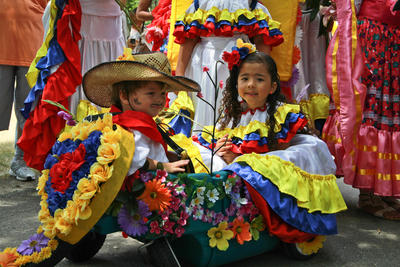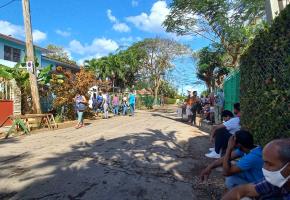Buenas, parceros. You have slaved away over textbooks for years, assiduously learning grammar rules, irregular verbs and adjective agreements. This is it: you’re pretty sure you’re bilingual now.
Then you arrive. Words fly at you from all sides making little sense, and you wonder why you bothered putting in the hours.
Landing in Spain can be bad enough – the Spanish reputation for taking things slowly does not extend to their speech. Yet Colombia is, to use the one and only English cliché you will find in this article, a completely different kettle of fish. I am not talking about a few slang words or folk expressions here or there; Colombia’s interpretation of the Spanish language often appears to be based on a resolute determination to avoid straight-talking. If there’s a good word available, another one will do. Hence the common expression: Llamemos a las cosas por su nombre (Let’s call things by their name) – used when a conversation becomes too confusing. Yet this is a land with a strong oral tradition, grounded in the storytelling from which both Magical Realism and vallenato music grew. It is, therefore, easy to forgive the nation’s creative manipulation of the spoken word. It is as integral a part of the culture as literature, music and food. Without understanding the ins and outs of the language, it is impossible to understand the country and its people.
In all probability, a new arrival will understand little at first. Even if you’re top of the class, or have spent long periods in Spain, the best you can usually hope for is to be mocked for speakingespañolete – the Spanish of a Spaniard (unless you have had the fortune to be taught by a Latin American). But there is hope yet. Candela attempts to have you echando carreta (see below) like a local with these few tips.
Purists: look away now.
Step 1. A few basics
Hola. ¿Qué más? Ok so it’s not technically wrong, but for starters we’d advise avoiding the overly Spanish ¿qué tal? for chats with friends and family. A casual ¿qué más? (possibly followed by an affectionate huevón) will do the trick and settle you down into conversation. For the more ambitious,¿Quiubo? (an abbreviation of ¿Qué hubo?) is a great option, best translated as “What’s up?”. Alternatively spelt ¿Q’hubo?, it even has a chain of sensationally sensationalist newspapers named after it: www.qhubo.com
The most fundamental tool in any aspiring Colombian’s vocabulary, however, is undoubtedly regalar. According to the dictionary: “to gift”. Yet the universal replacement of the worddar with regalar in order to say “to give” is an excellent way of appearing like someone who knows their way around. A sign of generosity or a sign of stinginess? It’s hard to tell.
The more conventional dar is acceptable, especially in formal register, but is more usefully learnt as part of the phrase dar papaya. Beware, however. The experience of many expatriate Colombians should be a lesson. Argentinean, Spanish, Chilean – or indeed most Spanish-speaking waiters outside of Colombia – will not appreciate the question: ¿me regalas la cuenta por favor?. It can be misinterpreted as asking for your meal for free.
Colombia is not a land full of chicos y chicas. Not even, for the most part, hombres y mujeres. A woman is, perhaps insultingly, known as una vieja (literally: an old girl), no matter her age. Best of all, a man is, quite appropriately, referred to as un man. Write this one down in your grammar books. The plural is not “men” but, magically:
Un man, Dos manes, Tres manes (etc…)
You may be spared if you’re still a kid, though, in which case you are a pelado or pelada (bald) or chino (Chinese). If anyone knows why, we’d be delighted to know.

Step 2. Put away the textbooks
Nothing is perfect, not even the past tense. A bit of a general Latin American one this one, but start adding too many auxiliary verbs to your participles in the past tense and you’ll be found out straight away. What you have learnt as the present perfect – “I have done” – is always the preterit or simple past – “I did” – in South American Spanish. As an example: he aprendido español en España becomes aprendí español en Colombia.
Who said Spanish was guttural and littered with lisps? Another general Latin American one here. Forget the heavy-handed pronunciation of the peninsula. Soften your Gs, hiss your Zs and Cs.
Get rid of those maths books too. A week, in Colombian time, lasts ocho días (eight days). Ergo: mañana en ocho,becomes “a week tomorrow”. It's a relief to find, however, that a second week does last seven days, making quince (15) díasmean two weeks. But then it all gets confusing again as a third week is only five days long, so if someone wants to see you in three weeks, it will be in veinte (20) días.
Again, answers for this numerical rationale on a postcard.
Step 3. Regáleme un minuto…

Give me a minute. The most useful phrase when you’re lost in Bogotá and out of credit on your phone. Approach any of the thousands of minuteros parked on each street corner doing exactly what their title suggests: selling minutes. You ask for a minute, they hand you a mobile, you make a call, you pay them around 200 pesos for each sixty seconds you talk. Theminuteros are as much a national institution in Colombia as red phone boxes in the UK.
Once you’ve found your minutero, your next task is to organise the farra – a night out. This is the perfect learning ground. If there’s a word worth knowing, it will said in the course of the piss-up.
First lesson. When it comes to ordering drinks, you wantaguardiente. You have no choice. It is imperative to ingratiate yourself with guaro – as it is more commonly known. Please,por el amor de dios, under no circumstances refer to the drink as “Firewater”, as many guidebooks disastrously insist on doing.
Guácala – the stuff is disgusting. Yes, I know, I’m sorry. And you are frying pans. That is to say, you are pailas – a very useful slang word referring to just about any desperate situation. But have no worries, there is a simple motto to apply if you do not wish to look like a boleta, pelota or güeva (a ticket, a ball or a testicle. That is to say: a spectacular idiot).
And the motto is…: with every shot, it tastes better. Comprobado por la NASA – as proven by NASA, you will undoubtedly be told. And then one day it clicks. Perhaps you’ve just killed your taste buds, but guaro will actually taste beautiful if you drink enough of it. Even the gomelitos – the niños play(what in Bogotá passes for a Sloane) – agree.
Now for the biggest news of all. In Colombia there are very fewresacas (hangovers). Instead, there are guayabos in abundance, along with people who are enguayabado – hung-over, its beautiful adjective. Colombian guayabos tend to be alot worse than Spanish resacas, probably due to aforementioned lethal substances. So they’d better be worth the pain. Our final section, if all goes well, will be the icing on the cake – the ají on the empanada. (This is NOT a real saying, I’m just getting hungry.)
¿Listo, mi'jito?
Step 4. Talk like a wet parrot
Believe it or not, this is the ultimate aim of this article: hablar como una lora mojada. A wet parrot is, obviously, the Colombian word for “chatterbox”.

We want you to be able to suck the chicken. That is, we need you to learn to mamar gallo. A graphic way, perhaps, to say “to take the mickey”, but a vital skill nonetheless. I think I'll spare you the picture.
The phrases that follow may make little sense literally. If you understand that this matters not one bit, you’re halfway there and will be mamando gallo better than Tino Asprilla.
Así que páreme bolas, mejor armemos un parche pa’ ir a echar carreta. Sólo que no vayan a sacarme la piedra haciendo un show.
What, you mean...?
"Stand my balls up, it’s probably best to begin arming a patch to be able to throw out the wagon. Just don’t go taking out my stone by making a show.
Mmmm. More like...
Pay attention (parar bolas). We should get a group of good people together (armar un parche) and go chew the fat (echar carreta). Just don’t make me angry (sacar la piedra) by throwing a tantrum (hacer un show).
Got it? It’s potato for the parrot – papita pa’l loro – right? Dead easy.
Learn all this, and you will never be unpatched (desparchado– all on your own) again…















